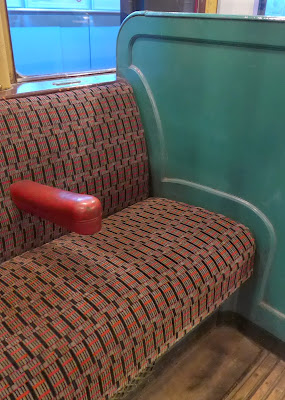It kind of fit, tunnel man and museumy woman's night out.
We've been before with our kids. Train spotting, bus spotting, collecting stamps as we went around, climbing on and off buses and trains, it's a kids dream and the museum is often very busy. It does cater brilliantly for kids.
We met in Covent Garden, the anorak was more train-spotting than London.
I couldn't help myself, I tweeted this photo.
I couldn't help myself, I tweeted this photo.
And was a little over excited to see my tweet on their Tweetwall.
So what would a night at the London Transport Museum have in store for us grown ups?
It had a bar, it was an over 18 event. We had Pimms.
It had a bar, it was an over 18 event. We had Pimms.
But more exciting than that, we got to play, be the kids, and notice things for ourselves. No earnest pointing things out to children.
We got to take #museumselfies (we're not very good at this yet),
...notice upholstery,
...and wooden floors. "Wood?"
"Actually look, the train is made of wood."
We noticed maps, the place where I grew up.
And got to chat to other people, who showed us their smart phones,
"that's were the line used to run".
Spotting the difference between then and now.
We saw that wood, for so many health and safety reasons, was replaced by metal,
...and steam replaced by
...by electricity.
More upholstery. This time I remember it.
We climbed on and off buses. "I don't remember them being quite so high. Perhaps I'm getting old." More evidence of yet a safer transport system, Routemasters didn't have doors,
...but they did have conductors and women in yellow trouser suits.
We saw an exhibition.
Then it was our turn for a bit of drawing. Inspired by the museum's amazing collection of transport posters, we got to make our own. Replacing the kids artwork, they're now on our fridge.
Building a tunnel. "Come on, you do this for a living."
Being a bus driver.
Just like every other family visiting a museum
(it is acknowledged in the museum literature!),
we went to the loo. And when it's quiet(er) you get to check out each cubicle.
Look what I found.
It wasn't fabric.
Don't wait until the next 'Museums at Night' in October to visit the London Transport Museum.
It's open every day. Not just for museum types and civil engineers.
Details on the London Transport Museum website here.
More about Museums at Night website here.
















































.JPG)

